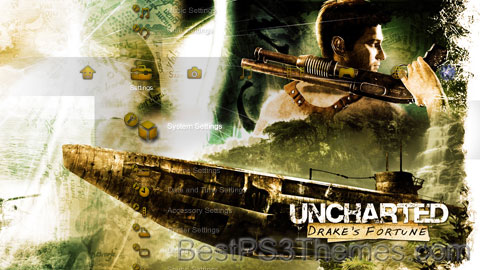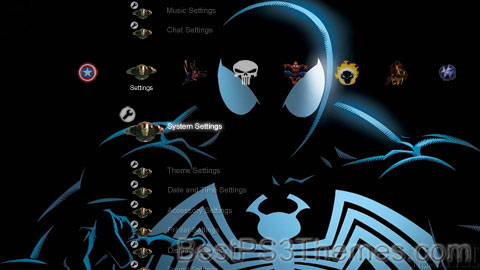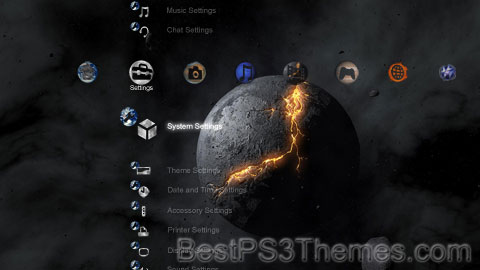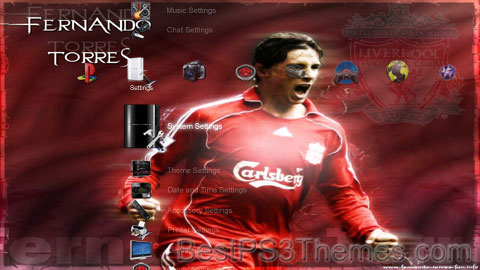Armin van Buuren theme by Racso
Download: ArminvanBuuren.p3t
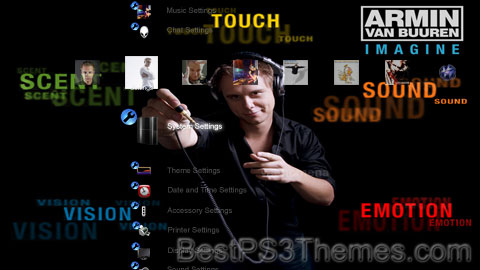
(3 backgrounds)
Armin van Buuren OON | |
|---|---|
 Van Buuren performing at the Armin Only Embrace show in Kyiv, 2017 | |
| Background information | |
| Birth name | Armin Jozef Jacobus Daniël van Buuren |
| Also known as | Rising Star, Perpetuous Dreamer |
| Born | 25 December 1976 Leiden, South Holland, Netherlands[1] |
| Origin | Koudekerk aan den Rijn, Netherlands |
| Genres | |
| Occupation(s) |
|
| Instrument(s) | |
| Years active | 1996–present |
| Labels |
|
| Spouse(s) |
Erika van Thiel (m. 2009) |
| Website | arminvanbuuren |
| Signature | |
 | |
Armin Jozef Jacobus Daniël van Buuren OON (/væn ˈbjʊərən/ van BURE-ən, Dutch: [ˈɑrmɪ ˈɲoːzəf jaːˈkoːbʏz ˈdaːnijɛl vɑm ˈbyːrə(n)]; born 25 December 1976)[1] is a Dutch DJ and record producer. Since 2001, he has hosted A State of Trance (ASOT), a weekly radio show, which is broadcast to nearly 40 million listeners in 84 countries on over 100 FM radio stations.[2] According to the website DJs and Festivals, "the radio show propelled him to stardom and helped cultivate an interest in trance music around the world".[3]
Van Buuren has won a number of accolades. He has been ranked the number one DJ by DJ Mag a record of five times, four years in a row.[4] He was ranked fifth on the DJ Mag Top 100 DJs list in 2022,[5] as well as fourth in 2015, 2016, 2019 and 2020,[6] and third in 2017.[7] In 2014, he was nominated for a Grammy Award for Best Dance Recording for his single "This Is What It Feels Like" featuring Trevor Guthrie,[8] which makes him the fourth trance artist ever to receive a Grammy Award nomination.[9] In the United States, he holds the record for most entries, twenty-one, on the Billboard Dance/Electronic Albums chart.[10]
Personal life[edit]
Armin van Buuren was born in Leiden, on 25 December 1976,[1] and grew up in Koudekerk aan den Rijn.[11] He was inspired by French electronic music composer Jean-Michel Jarre[12][13] and Dutch DJ and Remixer Ben Liebrand.[14] Van Buuren graduated from the Stedelijk Gymnasium Leiden in 1995, and studied law at Leiden University.[15] He began working as a DJ in Club Nexus in 1996,[16] playing multiple sets a week, most of which lasted six or more hours.[17] In 1999, he met Dave Lewis who introduced him as a DJ in England and the United States.[18] As his musical career began to take off, he put his law degree on hold, but he did return to graduate from law school in 2003.[19]
On 18 September 2009, van Buuren married Erika van Thiel.[20] Their daughter Fenna was born in July 2011.[21] van Buuren announced just hours before he was due to headline the main stage at Tomorrowland (27 July 2013) that his wife had given birth to a son, Remy.[22]
On 16 February 2018, van Buuren explored his family history in an episode of the TV series Verborgen verleden, the Dutch version of the UK series Who Do You Think You Are?.[23]
Music career[edit]
1996–1999: Early career and success[edit]
In 1996, van Buuren released EP and Push on Timeless Records. van Buuren had his first success with a track called "Blue Fear", which was released under the Cyber Records label in 1997. Another successful track, "Communication", was released under the same label and became popular in Ibiza, Spain in the summer of 1999.[24] After being signed to AM PM Records,[18] this track entered the UK Singles Chart at No. 18 in 2000.[25]
In the beginning of 1999, van Buuren started his label Armind together with United Recordings. The first release, Gig – "One", was well received. The second release, "Touch Me" under the name Rising Star, was signed to Ministry of Sound in the UK, before the record was released. By the time of his third release, Gimmick – "Free" was signed to R&S Records. During this year, he remixed the first two singles of Gouryella (Gouryella and Walhalla) and, under the guise of Rising Star, produced a remix of L'Esperanza, a song by Airscape.[26][27]
2000–2004: 76 and A State of Trance series[edit]
In 2000, Van Buuren started his own Armin van Buuren compilation series, a mix of progressive house and vocal trance styles of music. His first compilation album, A State of Trance (not to be confused with his weekly A State of Trance radio shows), sold 10,000 copies[28] and contains Van Buuren's remix of Moogwai, "Viola". Teaming up with Tiësto, two new projects were born: Major League – "Wonder Where You Are?" was released on Black Hole Recordings and Alibi – "Eternity" was released on Armind. "Eternity" received club and chart success and was signed to Paul van Dyk's imprint Vandit Records. Another major collaboration followed this. Together with Ferry Corsten, Van Buuren recorded a riff titled "Exhale[29]" for the System F album, Out of the Blue. Released as a single, this track reached Gold status.[30] Under the pseudonym Gaia he released "4 Elements" on Captivating Sounds, a sub-label of Warner Brothers.[31]
His second album, Basic Instinct featured a new track: Perpetuous Dreamer – "The Sound of Goodbye". This track entered the Dutch charts in June 2001 at number 26. Later in the year, the track hit No. 1 on the Hot Dance Music/Club Play chart.[32] The third album, In Motion was released 6 August 2001. A fourth album, Transparence, followed in 2002. In 2003, he worked with such artists such as DJ Seth Alan Fannin throughout a global tour on Dance Revolution in Europe, selling out to crowds of 20,000 people in the Netherlands.[33]
In March 2001, Van Buuren started his own radio show on ID&T Radio[34] (traditionally broadcast in Dutch and later English since ASOT 183). In this weekly two-hour show, entitled A State of Trance, he plays the latest popular trance music tracks, and publishes the artists and track titles on his website. When ID&T Radio changed genres in 2004, Van Buuren moved A State of Trance to Fresh FM and later SLAM!FM, two Dutch radio stations. It is now a weekly feature on Radio 538, the Dutch radio station,[35] DI.FM, an online radio station,[36] and on XM Satellite Radio, channel 52 in the United States and Canada.[37] A complete list of stations that broadcast A State of Trance can be found at the ASOT section of Armin's website.[38]
In 2002, he had a residency at Glow in Washington D.C.,[39] and played across North America. He regularly appeared at Amnesia on the island of Ibiza, Balearic Islands, Spain. In October that year, Van Buuren was voted number 5 in the DJ Mag.
In June 2003, Van Buuren celebrated the 100th episode of A State of Trance at Bloomingdale, Bloemendaal aan Zee, Netherlands and released his debut studio album, 76, a 76-minute album divided into 13 tracks.[40] In the same year he was voted No. 3 in the DJ Mag and held third place for the next two years (2004, 2005). Also in 2004, Van Buuren remixed the 24 theme song into a trance hit.
2005–2006: Shivers[edit]
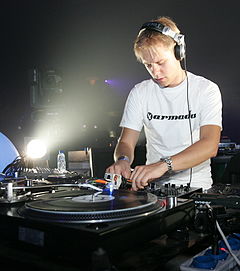
On 2 June 2005, he celebrated the 200th episode of A State of Trance at the Museumplein of Amsterdam. On 8 August 2005, Van Buuren released his second studio album, Shivers. On the album Van Buuren worked with artists such as Pakistani-American singer Nadia Ali, English singer Justine Suissa and American trance duo Gabriel & Dresden. On 25 May 2006, he celebrated with various artists the 250th episode of A State of Trance at Asta, The Hague, Netherlands. He was voted number two in the 2006 DJ Mag. On 17 May 2007, he celebrated with various artists the 300th episode of A State of Trance at Pettelaarse Schans, 's-Hertogenbosch, Netherlands.
2007–2009: Imagine[edit]
Van Buuren was elected best DJ in the world in the 2007 DJ Mag edition. On 12 January 2008, Van Buuren was given the "Buma Cultuur Pop Award," the most prestigious Dutch music award.[41] On 17 April 2008, Van Buuren released his third studio album, Imagine. It features collaboration with singers such as Jacqueline Govaert of Krezip. The album debuted at number one on the Dutch Albums Chart. The second single released from the album, "In and Out of Love", featuring Sharon den Adel from the band Within Temptation, has spawned a music video that has been viewed over 304 million times on YouTube.[42] Since the release of Imagine, Van Buuren has been working with Benno de Goeij of Rank 1 on solo productions and remixes.[citation needed] On 1 May 2008, he celebrated with various artists the 350th episode of A State of Trance at Noxx, Antwerp, Belgium. He was voted No. 1 in the 2008 DJ Mag again.
He collaborated with his brother, guitarist Eller van Buuren, at Together As One in Los Angeles, U.S., on New Year's Eve 2009, as well as on Armin's 2008 studio album Imagine. His performance with his brother at Together As One was also the last event of his Armin Only: Imagine world tour. To celebrate the 400th episode of A State of Trance, he performed at three shows with various artists in April, 2009 at Club Butan, Wuppertal, Germany, AIR, Birmingham, United Kingdom and Maassilo, Rotterdam, Netherlands.
Also in 2009, Foreign Media Games announced the production of Armin van Buuren: In the Mix, a music video game being produced in collaboration with Cloud 9 Music and Van Buuren's Armada Music label. The title was released on 12 November 2010 exclusively for the Wii console.[43] He was voted number one DJ in the 2009 DJ Mag for the third consecutive year.
2010–2012: Mirage and appointment to the Order of Orange-Nassau[edit]
On 3 March 2010, Van Buuren was awarded with the Golden Harp for his musical work and contribution to Dutch music, by Buma/Stemra at the 2010 Buma Harpen Gala in Hilversum, Netherlands.[44][45] To celebrate the 450th episode of A State of Trance, he performed with various artists at five shows across two continents. The locations were: The Guvernment, Toronto, Canada on 1 April 2010, Roseland Ballroom, New York City on 2 April and on 3 April again, Expo Arena, Bratislava, Slovakia on 9 April and Centennial Hall, Wroclaw, Poland on 24 April.
On 23 June 2010, it was announced that Van Buuren's fourth studio album, Mirage was due to be released on 10 September.[46] The first single "Full Focus", was released through iTunes Store on 24 June.[47] The song peaked at number 60 in the Netherlands. One of the confirmed tracks from the album is a collaboration with English singer Sophie Ellis-Bextor called "Not Giving Up on Love", which was released as a single from Bextor's fourth studio album, Make a Scene.[48][49] Armin also wrote a song for English singer Seal, but due to the release of his greatest hits album, Hits, the collaboration never came together.[50] On 12 September 2010, Van Buuren launched "A State of Sundays", a new weekly 24-hour radio show aired on Sirius XM Radio.[51] On 20 October 2010, Van Buuren won the award for Most Popular International DJ presented by The Golden Gnomes.[52] A week later he was announced, for the fourth year running, as the number one DJ in DJ Mag.[53]
The 2010 edition of Armin Only: Mirage kicked off in November 2010, in Utrecht, Netherlands, and was followed by shows in Saint Petersburg, Kyiv, Buenos Aires, Melbourne, Beirut, Poznań, Moscow and Bratislava.[54]
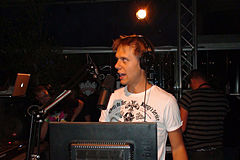
In March and April, 2011, celebrating the 500th episode of his radio show, Van Buuren performed five live shows along with various artists; the first was in Johannesburg, South Africa at MTN Expo Centre, and the second in Miami's Ultra Music Festival. He then performed in Argentina at GEBA in Buenos Aires, followed by a large event at Brabanthallen in Den Bosch, Netherlands which included more than 30 DJs from countries all over the world and was attended by over 30,000 people. The final show was held in Sydney on 16 April at Acer Arena. In 2011, Van Buuren was appointed Officer of the Order of Oranje-Nassau for services to Dutch dance and music economy.[55] That year he also received the Key to (Freedom) of Leiden from the City Mayor, as well as being voted No. 2 in the 2011 DJ Mag.
To celebrate the 550th episode of A State of Trance, he performed with various artists on two different continents during fourth weeks. The show was called A State of Trance 550: Invasion. The first event was celebrated at Ministry of Sound in London on 1 March 2012. On 7 March, Moscow held the second event at Expocentre. Kyiv's show was performed at International Exhibition Centre on 10 March. On 17 March, as part of the Beyond Wonderland festival in Los Angeles and on 25 March at the Ultra Music Festival in Miami. On 31 March, the biggest and final edition of ASOT 550 took place in the Brabanthallen of Den Bosch, Netherlands. On 19 October 2012, Van Buuren was announced for a fifth non-consecutive year as the world's number one DJ according to DJ Mag.[56]
To celebrate the 600th episode of A State of Trance, Van Buuren announced that he would perform with various artists all around the world in early 2013. The show was called A State of Trance 600: The Expedition. It was announced that the show would tour the world, including stops in Madrid, Mexico City, São Paulo, Minsk, Sofia, Beirut, Kuala Lumpur, Mumbai, Miami, Guatemala City, New York City, and Den Bosch.[57][58]
2013–2014: Intense[edit]
The first single of Van Buuren's fifth studio album, Intense, titled "This Is What It Feels Like", featured Canadian singer and songwriter Trevor Guthrie, and was released on 5 April 2013. The single nominated for a Grammy Award for Best Dance Recording.[59] The tour for the album, Armin Only: Intense, was announced on 17 October 2013.[60]
30 April 2013 saw the abdication of Queen Beatrix of the Netherlands in favor of her son, King Willem-Alexander of the Netherlands, who was sworn in and inaugurated that day, which was Queen's Day as well. Van Buuren was the headline act in a performance to a live audience celebrating the King's crowning in Amsterdam. While he was performing live together with the Royal Concertgebouw Orchestra in the Amsterdam Harbor on Java-eiland, King Willem-Alexander, Queen Máxima and their three daughters made an unplanned visit on stage.[61][62]
On 19 October 2013, Armin van Buuren was ranked number two DJ in the world by DJ Mag. On 26 January 2014, Armin van Buuren attended the 56th Grammy Awards, in relation to his Grammy Award nomination for the single featuring Trevor Guthrie, "This Is What It Feels Like" in the category of Best Dance Recording.
2015–2018: Embrace[edit]

On 8 May 2015, Armin van Buuren released the first single from his sixth studio album, Embrace, which was released on 29 October 2015.[63] The single is titled "Another You" featuring Mr Probz. Three weeks after releasing "Another You", Van Buuren also debuted another remix from Game of Thrones official theme which is originally made by composer Ramin Djawadi.[64]
On 16 October 2015 Armin van Buuren released the next single from Embrace called "Strong Ones" featuring Cimo Fränkel. This was followed by the release of his collaboration with Cosmic Gate "Embargo" on 22 October 2015. To accompany the album's release, Van Buuren announced the return of the Armin Only series of parties.
This edition of the tour was titled Armin Only: Embrace and took place throughout both 2015 and 2016. As the title of the tour suggests, it was based around the collection of music that he showcased on his new album.[65]
On 2 February 2017, Armin van Buuren officially opened a new A State of Trance radio show studio in Amsterdam as part of his celebrations for the 800th episode of the radio show. The studio is located in the Armada headquarters.[66] With the new accommodations made possible by the studio, he introduced a new segment of the radio show called Service for Dreamers where he invites fans to send in their favorite trance tracks that have a special meaning to them. Every week one track gets chosen to be featured live on the show and introduced by the fans of the radio show live, either by a walk-in, phone call, Skype or other means of contact.[67]
In 2017, Armin van Buuren announced he will be releasing an online MasterClass sharing his expertise in electronic music production.[68] On 13 April 2017, Armin van Buuren performed at the Heineken stage in Shanghai, in the first Formula 1 Festival along with Angela Zhang.[69]
Armin performed a seven-hour-long set at the Romania Untold Festival on 6 August 2018, clocking from 2:00 a.m. to after 9:00 a.m.[70] This outlasted his previous 2017 ASOT performance, which had gone on for five hours.[71]
2019–2023: Balance[edit]
On 6 October 2019, he performed at Republic Square, Yerevan, Armenia as an opening act for the World Congress on Information Technology (WCIT).[72]
On 25 October 2019, Armin released his seventh studio album, Balance.[73]
In January 2021, Armin celebrated the 1000th episode of A State of Trance with a 7-day long livestream, where he, co-host Ruben de Ronde and monthly show resident Ferry Corsten presented a list of the top 1000 songs played during A State of Trance radio shows, as voted on by listeners of the show.[74] The livestream ran from January 14 to January 21, and the top song was Shivers, from Armin's 2005 album. As has been done for previous radio show milestones, a major ASOT1000 festival was planned in Utrecht, but due to the COVID-19 pandemic, it has since been repeatedly delayed. The festival was held on March 4-5, 2023, by which point the weekly radio show have already surpassed 1100 episodes.[75]
2023–2024: Breathe In[edit]<
Jimi Hendrix #2
Jimi Hendrix theme by Joshua Luebke
Download: JimiHendrix_2.p3t
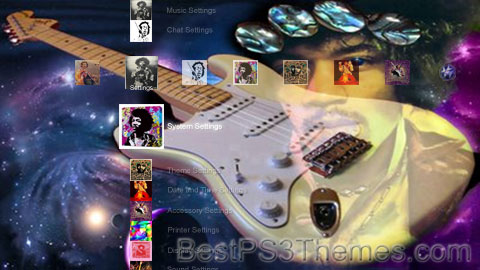
(4 backgrounds)
Jimi Hendrix | |
|---|---|
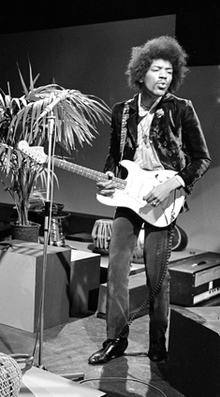 Hendrix performing on Hoepla in 1967 | |
| Background information | |
| Birth name | Johnny Allen Hendrix |
| Also known as | James Marshall Hendrix |
| Born | November 27, 1942 Seattle, Washington, US |
| Died | September 18, 1970 (aged 27) London, England |
| Genres | |
| Occupations |
|
| Instruments |
|
| Years active | 1962–1970 |
| Labels | |
| Formerly of |
|
| Website | jimihendrix |
| Signature | |
 | |
James Marshall "Jimi" Hendrix (born Johnny Allen Hendrix; November 27, 1942 – September 18, 1970) was an American guitarist, songwriter and singer. Although his mainstream career spanned only four years, he is widely regarded as the greatest and one of the most influential electric guitarists in the history of popular music, and one of the most celebrated musicians of the 20th century. The Rock and Roll Hall of Fame describes him as "arguably the greatest instrumentalist in the history of rock music."[1]
Born in Seattle, Washington, Hendrix began playing guitar at age 15. In 1961, he enlisted in the US Army, but was discharged the following year. Soon afterward, he moved to Clarksville, then Nashville, Tennessee, and began playing gigs on the chitlin' circuit, earning a place in the Isley Brothers' backing band and later with Little Richard, with whom he continued to work through mid-1965. He then played with Curtis Knight and the Squires before moving to England in late 1966 after bassist Chas Chandler of the Animals became his manager. Within months, Hendrix had earned three UK top ten hits with his band, the Jimi Hendrix Experience (consisting of bassist Noel Redding, drummer Mitch Mitchell, and Hendrix himself): "Hey Joe", "Purple Haze", and "The Wind Cries Mary". He achieved fame in the US after his performance at the Monterey Pop Festival in 1967, and in 1968 his third and final studio album, Electric Ladyland, reached number one in the US. The double LP was Hendrix's most commercially successful release and his only number one album. The world's highest-paid rock musician,[2] he headlined the Woodstock Festival in 1969 and the Isle of Wight Festival in 1970 before his accidental death in London from barbiturate-related asphyxia in September 1970.
Hendrix was inspired by American rock and roll and electric blues. He favored overdriven amplifiers with high volume and gain, and was instrumental in popularizing the previously undesirable sounds caused by guitar amplifier feedback. He was also one of the first guitarists to make extensive use of tone-altering effects units in mainstream rock, such as fuzz distortion, Octavia, wah-wah, and Uni-Vibe. He was the first musician to use stereophonic phasing effects in recordings. Holly George-Warren of Rolling Stone commented: "Hendrix pioneered the use of the instrument as an electronic sound source. Players before him had experimented with feedback and distortion, but Hendrix turned those effects and others into a controlled, fluid vocabulary every bit as personal as the blues with which he began."[3]
Hendrix was the recipient of several music awards during his lifetime and posthumously. In 1967, readers of Melody Maker voted him the Pop Musician of the Year and in 1968, Billboard named him the Artist of the Year and Rolling Stone declared him the Performer of the Year. Disc and Music Echo honored him with the World Top Musician of 1969 and in 1970, Guitar Player named him the Rock Guitarist of the Year. The Jimi Hendrix Experience was inducted into the Rock and Roll Hall of Fame in 1992 and the UK Music Hall of Fame in 2005. Rolling Stone ranked the band's three studio albums, Are You Experienced (1967), Axis: Bold as Love (1967), and Electric Ladyland (1968), among the "500 Greatest Albums of All Time", and they ranked Hendrix as the greatest guitarist and the sixth-greatest artist of all time. Hendrix was named the greatest guitarist of all time by Rolling Stone in 2023.[4]
Ancestry and childhood[edit]

Hendrix was of African American and alleged Cherokee descent.[nb 1] His paternal grandfather, Bertran Philander Ross Hendrix, was born in 1866 from an extramarital affair between a woman named Fanny and a grain merchant from Urbana, Ohio, or Illinois, one of the wealthiest men in the area at that time.[11][nb 2] Hendrix's paternal grandmother, Zenora "Nora" Rose Moore, was a former dancer and vaudeville performer who co-founded Fountain Chapel in Hogan's Alley.[13] Hendrix and Moore relocated to Vancouver, Canada, where they had a son they named James Allen Hendrix on June 10, 1919; the family called him "Al".[14]
In 1941, after moving to Seattle, Washington, Al met Lucille Jeter (1925–1958) at a dance; they married on March 31, 1942.[15] Lucille's father (Jimi's maternal grandfather) was Preston Jeter (born 1875), whose mother was born in similar circumstances as Bertran Philander Ross Hendrix.[16] Lucille's mother, Clarice (née Lawson), had African American ancestors who had been enslaved people.[17] Al, who had been drafted by the US Army to serve in World War II, left to begin his basic training three days after the wedding.[18] Johnny Allen Hendrix was born on November 27, 1942, in Seattle; he was the first of Lucille's five children. In 1946, Johnny's parents changed his name to James Marshall Hendrix, in honor of Al and his late brother Leon Marshall.[19][nb 3]
Stationed in Alabama at the time of Hendrix's birth, Al was denied the standard military furlough afforded servicemen for childbirth; his commanding officer placed him in the stockade to prevent him from going AWOL to see his infant son in Seattle. He spent two months locked up without trial, and, while in the stockade, received a telegram announcing his son's birth.[13][nb 4] During Al's three-year absence, Lucille struggled to raise their son.[23] When Al was away, Hendrix was mostly cared for by family members and friends, especially Lucille's sister Delores Hall and her friend Dorothy Harding.[24] Al received an honorable discharge from the US Army on September 1, 1945. Two months later, unable to find Lucille, Al went to the Berkeley, California, home of a family friend named Mrs. Champ, who had taken care of and attempted to adopt Hendrix; this is where Al saw his son for the first time.[25]
After returning from service, Al reunited with Lucille, but his inability to find steady work left the family impoverished. They both struggled with alcohol, and often fought when intoxicated. The violence sometimes drove Hendrix to withdraw and hide in a closet in their home.[26] His relationship with his brother Leon (born 1948) was close but precarious; with Leon in and out of foster care, they lived with an almost constant threat of fraternal separation.[27] In addition to Leon, Hendrix had three younger siblings: Joseph, born in 1949, Kathy in 1950, and Pamela in 1951, all of whom Al and Lucille gave up to foster care and adoption.[28] The family frequently moved, staying in cheap hotels and apartments around Seattle. On occasion, family members would take Hendrix to Vancouver to stay at his grandmother's. A shy and sensitive boy, he was deeply affected by his life experiences.[29] In later years, he confided to a girlfriend that he had been the victim of sexual abuse by a man in uniform.[30] On December 17, 1951, when Hendrix was nine years old, his parents divorced; the court granted Al custody of him and Leon.[31]
First instruments[edit]
At Horace Mann Elementary School in Seattle during the mid-1950s, Hendrix's habit of carrying a broom with him to emulate a guitar gained the attention of the school's social worker. After more than a year of his clinging to a broom like a security blanket, she wrote a letter requesting school funding intended for underprivileged children, insisting that leaving him without a guitar might result in psychological damage.[32] Her efforts failed, and Al refused to buy him a guitar.[32][nb 5]
In 1957, while helping his father with a side-job, Hendrix found a ukulele among the garbage they were removing from an older woman's home. She told him that he could keep the instrument, which had only one string.[34] Learning by ear, he played single notes, following along to Elvis Presley songs, particularly "Hound Dog".[35][nb 6] By the age of 33, Hendrix's mother Lucille had developed cirrhosis of the liver, and on February 2, 1958, she died when her spleen ruptured.[37] Al refused to take James and Leon to attend their mother's funeral; he instead gave them shots of whiskey and told them that was how men should deal with loss.[37][nb 7] In 1958, Hendrix completed his studies at Washington Junior High School and began attending, but did not graduate from, Garfield High School.[38][nb 8]
In mid-1958, at age 15, Hendrix acquired his first acoustic guitar, for $5[41] (equivalent to $53 in 2023). He played for hours daily, watching others and learning from more experienced guitarists, and listening to blues artists such as Muddy Waters, B.B. King, Howlin' Wolf, and Robert Johnson.[42] The first tune Hendrix learned to play was the television theme "Peter Gunn".[43] Around that time, Hendrix jammed with boyhood friend Sammy Drain and his keyboard-playing brother.[44] In 1959, attending a concert by Hank Ballard & The Midnighters in Seattle, Hendrix met the group's guitarist Billy Davis.[45] Davis showed him some guitar licks and got him a short gig with the Midnighters.[46] The two remained friends until Hendrix's death in 1970.[47]
Soon after he acquired the acoustic guitar, Hendrix formed his first band, the Velvetones. Without an electric guitar, he could barely be heard over the sound of the group. After about three months, he realized that he needed an electric guitar.[48] In mid-1959, his father relented and bought him a white Supro Ozark.[48] Hendrix's first gig was with an unnamed band in the Jaffe Room of Seattle's Temple De Hirsch, but they fired him between sets for showing off.[49] He joined the Rocking Kings, which played professionally at venues such as the Birdland club. When his guitar was stolen after he left it backstage overnight, Al bought him a red Silvertone Danelectro.[50]
Military service[edit]
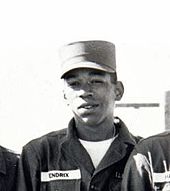
Before Hendrix was 19 years old, law authorities had twice caught him riding in stolen cars. Given a choice between prison or joining the Army, he chose the latter and enlisted on May 31, 1961.[51] After completing eight weeks of basic training at Fort Ord, California, he was assigned to the 101st Airborne Division and stationed at Fort Campbell, Kentucky.[52] He arrived on November 8, and soon afterward he wrote to his father: "There's nothing but physical training and harassment here for two weeks, then when you go to jump school ... you get hell. They work you to death, fussing and fighting."[53] In his next letter home, Hendrix, who had left his guitar in Seattle at the home of his girlfriend Betty Jean Morgan, asked his father to send it to him as soon as possible, stating: "I really need it now."[53] His father obliged and sent the red Silvertone Danelectro on which Hendrix had hand-painted the words "Betty Jean" to Fort Campbell.[54] His apparent obsession with the instrument contributed to his neglect of his duties, which led to taunting and physical abuse from his peers, who at least once hid the guitar from him until he had begged for its return.[55] In November 1961, fellow serviceman Billy Cox walked past an army club and heard Hendrix playing.[56] Impressed by Hendrix's technique, which Cox described as a combination of "John Lee Hooker and Beethoven", Cox borrowed a bass guitar and the two jammed.[57] Within weeks, they began performing at base clubs on the weekends with other musicians in a loosely organized band, the Casuals.[58]
Hendrix completed his paratrooper training and, on January 11, 1962, Major General Charles W. G. Rich awarded him the prestigious Screaming Eagles patch.[53] By February, his personal conduct had begun to draw criticism from his superiors. They labeled him an unqualified marksman and often caught him napping while on duty and failing to report for bed checks.[59] On May 24, Hendrix's platoon sergeant, James C. Spears, filed a report in which he stated: "He has no interest whatsoever in the Army ... It is my opinion that Private Hendrix will never come up to the standards required of a soldier. I feel that the military service will benefit if he is discharged as soon as possible."[60] On June 29, 1962, Hendrix was granted a general discharge under honorable conditions.[61] Hendrix later spoke of his dislike of the army and that he had received a medical discharge after breaking his ankle during his 26th parachute jump,[62][nb 9] but no Army records have been produced that indicate that he received or was discharged for any injuries.[64]
Career[edit]
Early years[edit]
In September 1962, after Cox was discharged from the Army, he and Hendrix moved about 20 miles (32 km) across the state line from Fort Campbell to Clarksville, Tennessee, and formed a band, the King Kasuals.[65] In Seattle, Hendrix saw Butch Snipes play with his teeth and now the Kasuals' second guitarist, Alphonso "Baby Boo" Young, was performing this guitar gimmick.[66] Not to be upstaged, Hendrix also learned to play in this way. He later explained: "The idea of doing that came to me ... in Tennessee. Down there you have to play with your teeth or else you get shot. There's a trail of broken teeth all over the stage."[67]
Although they began playing low-paying gigs at obscure venues, the band eventually moved to Nashville's Jefferson Street, which was the traditional heart of the city's black community and home to a thriving rhythm and blues music scene.[68] They earned a brief residency playing at a popular venue in town, the Club del Morocco, and for the next two years Hendrix made a living performing at a circuit of venues throughout the South that were affiliated with the Theater Owners Booking Association (TOBA), widely known as the chitlin' circuit.[69] In addition to playing in his own band, Hendrix performed as a backing musician for various soul, R&B, and blues musicians, including Wilson Pickett, Slim Harpo, Sam Cooke, Ike & Tina Turner[70] and Jackie Wilson.[71]
In January 1964, feeling he had outgrown the circuit artistically, and frustrated by having to follow the rules of bandleaders, Hendrix decided to venture out on his own. He moved into the Hotel Theresa in Harlem, where he befriended Lithofayne Pridgon, known as "Faye", who became his girlfriend.[72] A Harlem native with connections throughout the area's music scene, Pridgon provided him with shelter, support, and encouragement.[73] Hendrix also met the Allen twins, Arthur and Albert.[74][nb 10] In February 1964, Hendrix won first prize in the Apollo Theater amateur contest.[76] Hoping to secure a career opportunity, he played the Harlem club circuit and sat in with various bands. At the recommendation of a former associate of Joe Tex, Ronnie Isley granted Hendrix an audition that led to an offer to become the guitarist with the Isley Brothers' backing band, the I.B. Specials, which he readily accepted.[77]
First recordings[edit]
In March 1964, Hendrix recorded the two-part single "Testify" with the Isley Brothers. Released in June, it failed to chart.[78] In May, he provided guitar instrumentation for the Don Covay song, "Mercy Mercy". Issued in August by Rosemart Records and distributed by Atlantic, the track reached number 35 on the Billboard chart.[79]
Hendrix toured with the Isleys during much of 1964, but near the end of October, after growing tired of playing the same set every night, he left the band.[80][nb 11] Soon afterward, Hendrix joined Little Richard's touring band, the Upsetters.[82] During a stop in Los Angeles in February 1965, he recorded his first and only single with Richard, "I Don't Know What You Got (But It's Got Me)", written by Don Covay and released by Vee-Jay Records.[83] Richard's popularity was waning at the time, and the single peaked at number 92, where it remained for one week before dropping off the chart.[84][nb 12] Hendrix met singer Rosa Lee Brooks while staying at the Wilcox Hotel in Hollywood, and she invited him to participate in a recording session for her single, which included the Arthur Lee penned "My Diary" as the A-side, and "Utee" as the B-side.[86] Hendrix played guitar on both tracks, which also included background vocals by Lee. The single failed to chart, but Hendrix and Lee began a friendship that lasted several years; Hendrix later became an ardent supporter of Lee's band, Love.[86]
In July 1965, Hendrix made his first television appearance on Nashville's Channel 5 Night Train. Performing in Little Richard's ensemble band, he backed up vocalists Buddy and Stacy on "Shotgun". The video recording of the show marks the earliest known footage of Hendrix performing.[82] Richard and Hendrix often clashed over tardiness, wardrobe, and Hendrix's stage antics, and in late July, Richard's brother Robert fired him.[87]
On July 27, Hendrix signed his first recording contract with Juggy Murray at Sue Records and Copa Management.[88][89] He then briefly rejoined the Isley Brothers, and recorded a second single with them, "Move Over and Let Me Dance" backed with "Have You Ever Been Disappointed".[90] Later that year, he joined a New York-based R&B band, Curtis Knight and the Squires, after meeting Knight in the lobby of a hotel where both men were staying.[91] Hendrix performed with them for eight months.[92]
In October 1965, he and Knight recorded the single, "How Would You Feel" backed with "Welcome Home". Despite his two-year contract with Sue,[93] Hendrix signed a three-year recording contract with entrepreneur Ed Chalpin on October 15.[94] While the relationship with Chalpin was short-lived, his contract remained in force, which later caused legal and career problems for Hendrix.[95][nb 13] During his time with Knight, Hendrix briefly toured with Joey Dee and the Starliters, and worked with King Curtis on several recordings including Ray Sharpe's two-part single, "Help Me".[97] Hendrix earned his first composer credits for two instrumentals, "Hornets Nest" and "Knock Yourself Out", released as a Curtis Knight and the Squires single in 1966.[98][nb 14]
Feeling restricted by his experiences as an R&B sideman, Hendrix moved in 1966 to New York City's Greenwich Village, which had a vibrant and diverse music scene.[103] There, he was offered a residency at the Cafe Wha? on MacDougal Street and formed his own band that June, Jimmy James and the Blue Flames, which included future Spirit guitarist Randy California.[104][nb 15] The Blue Flames played at several clubs in New York and Hendrix began developing his guitar style and material that he would soon use with the Experience.[106][107] In September, they gave some of their last concerts at the Cafe Au Go Go in Manhattan, as the backing group for a singer and guitarist then billed as John Hammond.[108][nb 16]
The Jimi Hendrix Experience[edit]
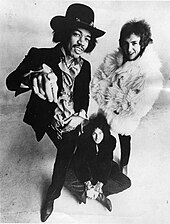
By May 1966, Hendrix was struggling to earn a living wage playing the R&B circuit, so he briefly rejoined Curtis Knight and the Squires for an engagement at one of New York City's most popular nightspots, the Cheetah Club.[109] During a performance, Linda Keith, the girlfriend of Rolling Stones guitarist Keith Richards, noticed Hendrix and was "mesmerised" by his playing.[109] She invited him to join her for a drink, and the two became friends.[109]
While Hendrix was playing as Jimmy James and the Blue Flames, Keith recommended him to Stones manager Andrew Loog Oldham and producer Seymour Stein. They failed to see Hendrix's musical potential and rejected him.[110] Keith referred him to Chas Chandler, who was leaving the Animals and was interested in managing and producing artists.[111] Chandler saw Hendrix play in
Victoria Frances theme by Doumah Download: VictoriaFrances.p3t Redirect to: Grindhouse theme by DDC Download: Grindhouse_2.p3t
A grindhouse or action house[1] is an American term for a theatre that mainly shows low-budget horror, splatter, and exploitation films for adults. According to historian David Church, this theater type was named after the "grind policy", a film-programming strategy dating back to the early 1920s which continuously showed films at cut-rate ticket prices that typically rose over the course of each day. This exhibition practice was markedly different from the era's more common practice of fewer shows per day and graduated pricing for different seating sections in large urban theatres, which were typically studio-owned.
Due to these theaters' proximity to controversially sexualized forms of entertainment like burlesque, the term "grindhouse" has often been erroneously associated with burlesque theaters in urban entertainment areas such as 42nd Street in New York City,[2][3] where bump and grind dancing and striptease were featured.[4] In the film Lady of Burlesque (1943) one of the characters refers to one such burlesque theatre on 42nd Street as a "grindhouse," but Church points out the primary definition in the Oxford English Dictionary is for a movie theater distinguished by three criteria:[2]
Church states the first use of the term "grind house" was in a 1923 Variety article,[5] which may have adopted the contemporary slang usage of "grind" to refer to the actions of barkers exhorting potential patrons to enter the venue.[2]
Double, triple, and "all night" bills on a single admission charge often encouraged patrons to spend long periods of time in the theaters.[6] The milieu was largely and faithfully captured at the time by the magazine Sleazoid Express.
Because grindhouse theaters were associated with a lower class audience, grindhouse theaters gradually became perceived as disreputable places that showed disreputable films, regardless of the variety of films – including subsequent-run Hollywood films – that were actually screened.[7] Similar second-run screenings are held at discount theaters and neighborhood theatres; the distinguishing characteristics of the "grindhouse" are its typical urban setting and the programming of first-run films of low merit, not predominantly second-run films which had received wide releases.
The introduction of television greatly eroded the audience for local and single-screen movie theaters, many of which were built during the cinema boom of the 1930s. In combination with urban decay after white flight out of older city areas in the mid to late 1960s, changing economics forced these theaters to either close or offer something that television could not. In the 1970s, many of these theaters became venues for exploitation films,[4] such as adult pornography and sleaze, or slasher horror, and dubbed martial arts films from Hong Kong.[8]
Films shot for and screened at grindhouses characteristically contain large amounts of sex, violence, or bizarre subject matter. One featured genre were "roughies" or sexploitation films, a mix of sex, violence and sadism. Quality varied, but low budget production values and poor print quality were common. Critical opinions varied regarding typical grindhouse fare, but many films acquired cult following and critical praise.
By the mid 1980s, home video and cable movie channels threatened to render the grindhouse obsolete. By the end of the decade, these theaters had vanished from Los Angeles's Broadway and Hollywood Boulevard, New York City's Times Square and San Francisco's Market Street. Another example was the Jolar Theater in Nashville, Tennessee, on lower Broadway, which was active until it burned down on April 14, 1978.[9]
By the mid-1990s, these particular theaters had all but disappeared from the United States. Excerpts from Sleazoid Express, an exploitation aficionado newsletter that ran in the 1980s, were compiled into a book of the same title by authors Bill Landis and Michelle Clifford; the book discusses various exploitation subgenres as well as New York City's 42nd Street grindhouses themselves.
Victoria Frances
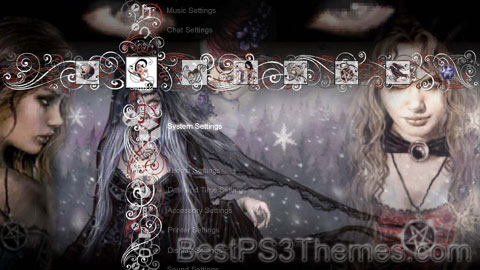
(2 backgrounds)
Grindhouse #2
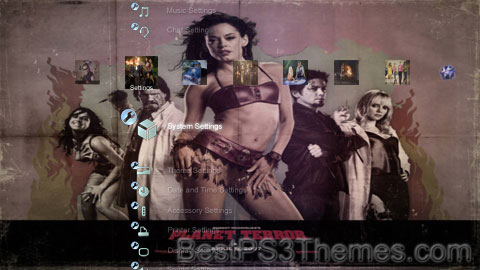
(8 backgrounds)

History[edit]
Television pressure[edit]
Content[edit]
Decline[edit]
Gallery[edit]
See also[edit]
References[edit]
I spent my first night in San Diego sleeping in the back row of the Cabrillo Theater.
In that pre-Gaslamp, pre-multiplex downtown of 1978 or so, half a dozen wonderfully eclectic – if mildly disreputable – late night movie houses operated within a few blocks of each other. Each grindhouses was a colorful oasis, plopped down in the middle of a seedy urban sprawl perfectly suited to the sailors on shore leave and porn aficionados that comprised much of its foot traffic.
A couple of bucks got you a double or triple bill, screened 'round the clock in cavernous single-screen movie theaters harkening back to Hollywood's golden age, rich in cinematic history and replete with big wide aisles and accommodating balconies. Horton Plaza had the Carbillo [sic] and the Plaza Theater, both operated by Walnut Properties, whose owner Vince Miranda maintained a suite at the Hotel San Diego (which he also owned).Because grindhouse theaters were nasty places, full of nasty people, and most of us wouldn't be caught dead in one. The few folks who were there for the actual movies were either poverty tourists or cinephiles who didn't notice anything except the flickering screen, and, in many cases, their cinephilia had burned out their sense of discrimination, because a lot of the movies that showed in grindhouses were bad.
Bibliography[edit]
External links[edit]
![]()






